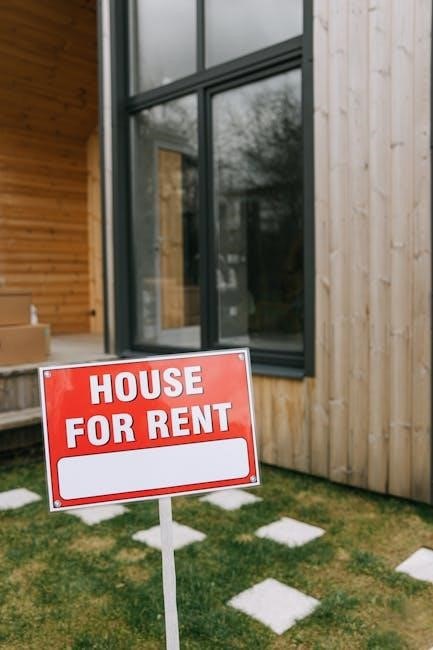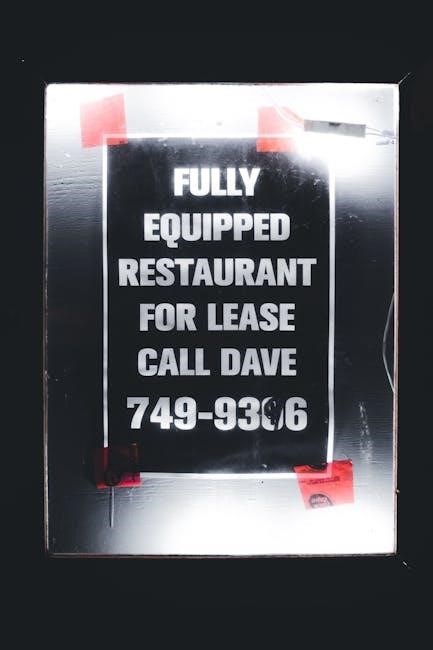A rent-to-own lease agreement is a legal contract allowing tenants to rent a property with the option to purchase it later, combining rental payments with future ownership rights.
1.1 Definition and Purpose
A rent-to-own lease agreement is a legal contract between a landlord and tenant, allowing the tenant to rent a property with the option to purchase it in the future. This arrangement enables tenants to build equity while renting, with a portion of monthly payments often applied toward the purchase price. It provides an alternative path to homeownership, especially for those needing time to secure financing; The agreement outlines terms like rent, lease duration, and purchase options, benefiting both parties by offering stability and potential ownership.
1.2 Benefits for Tenants and Landlords
Tenants benefit from rent-to-own agreements by building equity through rent payments and gaining time to improve creditworthiness. This setup allows them to live in a property while working toward ownership. For landlords, it attracts serious tenants, often resulting in better property maintenance and stable income. Rent-to-own agreements also provide tax benefits and reduce turnover, offering a mutually advantageous arrangement for both parties.

Key Components of a Rent-to-Own Lease Agreement
A rent-to-own lease agreement includes the rental term, purchase option, rent credit, purchase price, and maintenance responsibilities, ensuring clarity and legal protection for both tenant and landlord.
2.1 Rental Term and Purchase Option
The rental term in a rent-to-own lease agreement specifies the duration of the tenancy, typically ranging from 1 to 5 years. During this period, the tenant pays monthly rent, with a portion allocated as a rent credit toward the purchase price. The agreement also outlines the purchase option, granting the tenant the exclusive right to buy the property at a predetermined price or based on market value at the end of the term. Both parties must clearly understand these terms to avoid disputes.
2.2 Rent Credit and Purchase Price
In a rent-to-own lease agreement, a portion of the monthly rent is allocated as a rent credit, which is applied toward the purchase price of the property. The purchase price is typically agreed upon at the start of the agreement and may be fixed or based on the property’s future market value. The rent credit amount varies but often ranges between 10% to 20% of the monthly rent. Both parties must clearly agree on these terms to ensure transparency and avoid disputes during the lease period.
2.3 Maintenance and Repair Responsibilities
In a rent-to-own lease agreement, maintenance and repair responsibilities are typically outlined to clarify the roles of both the tenant and landlord. Generally, the tenant is responsible for routine maintenance and minor repairs to maintain the property’s condition. Major structural repairs, such as issues with the roof or foundation, often fall under the landlord’s responsibility. The agreement should specify these duties to avoid disputes and ensure the property remains well-maintained throughout the lease period.
2.4 Default and Termination Clauses
Default and termination clauses outline the conditions under which the rent-to-own agreement can be terminated. If the tenant fails to make timely payments or breaches the contract, the landlord may issue a notice of default. The tenant typically has a specified period to cure the default. If unresolved, the landlord can terminate the agreement, forfeit the rent credits, and take possession of the property. These clauses protect both parties by clarifying the consequences of non-compliance and ensuring a clear resolution process.

Types of Rent-to-Own Agreements
Rent-to-own agreements come in two primary forms: lease option agreements and lease purchase agreements, each offering distinct terms for tenants aiming to transition from renting to owning a property.
3.1 Lease Option Agreements
A lease option agreement grants tenants the exclusive right to purchase the property within a specified period, typically in exchange for an option fee. This type of agreement allows tenants to rent the property while retaining the option to buy it in the future. It is often preferred for its flexibility, as tenants are not immediately obligated to purchase. The agreement outlines the terms, including the rental period, option fee, and the portion of rent applied toward the purchase price, benefiting both parties by providing a clear path to ownership.
3.2 Lease Purchase Agreements
A lease purchase agreement obligates the tenant to buy the property at the end of the lease term. Unlike lease option agreements, this arrangement requires the tenant to commit to purchasing the property. The rental payments are applied to the purchase price, and the tenant typically pays a higher rent. This type of agreement is ideal for tenants who are certain about buying the property. The terms are legally binding, and ownership transfers automatically at the end of the lease period, provided all conditions are met;

How to Create a Rent-to-Own Lease Agreement
Creating a rent-to-own lease agreement involves drafting a document outlining property details, rental terms, purchase options, and responsibilities. Ensure clarity and legal compliance to avoid disputes.
4.1 Drafting the Agreement
Drafting a rent-to-own lease agreement involves outlining property details, rental terms, and purchase options. Include the lease duration, monthly rent, rent credit, and purchase price. Specify maintenance responsibilities and default clauses. Use clear language to avoid disputes; Customize templates to suit your needs, ensuring legal compliance. Attach a separate addendum for additional terms if required. A well-drafted agreement protects both tenant and landlord rights, ensuring a smooth transaction and potential property transfer.
4.2 Negotiating Terms
Negotiating terms in a rent-to-own lease agreement ensures both parties’ interests are aligned. Key areas include rent credit, purchase price, and lease duration. Tenants may seek lower monthly payments, while landlords may prioritize higher rent credits. Clearly define responsibilities for maintenance and repairs. Open communication helps reach mutually beneficial terms. Ensure all negotiated points are documented in the final agreement to avoid future disputes. A fair and transparent negotiation process fosters trust and sets the foundation for a successful rent-to-own arrangement.
4.3 Signing and Executing the Agreement
Once all terms are finalized, both the landlord and tenant must sign the rent-to-own lease agreement. Witnesses or a notary may be required to validate the document. Ensure all parties receive a copy for their records. The signed agreement becomes legally binding, outlining the responsibilities and obligations of both parties. Proper execution ensures clarity and protects the interests of both the tenant and landlord, confirming the rent-to-own arrangement is official and enforceable under the agreed terms.
4.4 Filing and Documentation
After signing, both parties should retain copies of the rent-to-own lease agreement. It is essential to file the document securely, either physically or digitally, for future reference. Ensure all terms, including the rental period, purchase option, and rent credits, are clearly documented. Proper documentation helps prevent disputes and provides legal proof of the agreement. Consider using PDF formats for easy storage and sharing. Maintain backups and ensure the agreement is accessible to both tenant and landlord for the duration of the lease and beyond.

Legal Considerations
Rent-to-own agreements must comply with state and local laws. Legal reviews ensure fairness and transparency, protecting both tenants and landlords from potential disputes and misunderstandings.
5.1 State and Local Laws
Rent-to-own agreements are governed by state and local laws, which vary by jurisdiction. These laws regulate disclosures, option fees, and rent credit structures to ensure compliance. Proper legal reviews are essential to avoid disputes and ensure the agreement is legally binding. Tenants and landlords must adhere to specific requirements, such as written disclosures about property conditions and tenant rights. Failure to comply can result in legal consequences, making it crucial to understand and follow local regulations when drafting a rent-to-own lease agreement.
5.2 Tenant and Landlord Rights
Rent-to-own agreements must balance the rights of both tenants and landlords. Tenants gain the exclusive option to purchase the property during the lease term, while landlords retain ownership until the purchase is finalized. Tenants are entitled to fair treatment, clear disclosures about the property’s condition, and protection from unfair eviction. Landlords, however, are entitled to timely rent payments and must be notified of any issues with the property. Both parties should understand their responsibilities and rights to avoid disputes and ensure a smooth transaction. Proper documentation is key to protecting these rights;
5.3 Tax Implications
Rent-to-own agreements involve specific tax considerations. Tenants may deduct a portion of their rent as interest on their taxes if part of the payment is applied to the purchase price. Landlords, however, must report rental income and may benefit from depreciation deductions. The tax treatment varies depending on the agreement’s structure and local regulations. Consulting a tax professional is essential to ensure compliance and optimize financial benefits for both parties. Understanding these implications helps both tenants and landlords make informed decisions.
5.4 Insurance and Liability
Insurance and liability considerations are crucial in rent-to-own agreements. Typically, landlords maintain property insurance, while tenants may need renter’s insurance for personal belongings. Liability for property damage often falls on the tenant if caused by negligence. Both parties should clarify insurance responsibilities in the agreement to avoid disputes. It’s essential to review insurance policies to ensure adequate coverage and understand liability terms, protecting both tenant and landlord interests throughout the rental period.

Common Mistakes to Avoid
Common mistakes in rent-to-own agreements include unclear terms, insufficient legal review, and misunderstandings about rent credits, which can lead to disputes and financial complications for both parties.
6.1 Lack of Clear Terms
A common mistake in rent-to-own agreements is the absence of clear terms, leading to confusion and disputes. Ambiguous language regarding rent credits, purchase prices, and termination clauses can cause misunderstandings. Without explicit details on maintenance responsibilities and payment structures, both tenants and landlords may face legal and financial challenges. It is essential to outline all conditions clearly to ensure both parties understand their obligations and rights. A well-defined agreement helps prevent conflicts and ensures a smooth process for all involved.
6.2 Insufficient Legal Review
Many rent-to-own agreements fail due to inadequate legal review, which can lead to unenforceable terms or overlooked legal requirements. Without proper oversight, both tenants and landlords may face issues like invalid contract clauses or non-compliance with local laws. Consulting a legal professional ensures the agreement aligns with state and local regulations, protecting both parties’ interests. A thorough legal review is crucial to avoid potential disputes and ensure the contract’s validity and enforceability. This step is often overlooked but is essential for a secure and legally sound agreement.
6.3 Misunderstanding Rent Credits
Misunderstanding rent credits is a common pitfall in rent-to-own agreements. Many tenants assume all rental payments apply toward the purchase price, but often only a portion does. Landlords may specify a fixed amount or percentage allocated as credit. Without clear terms, tenants may overpay or feel misled. It is essential to define rent credits explicitly, ensuring both parties understand how they contribute to the final purchase price. Ambiguity here can lead to disputes, highlighting the need for transparent and detailed agreements. Proper documentation is key to avoiding such misunderstandings and ensuring mutual clarity.
Best Practices for Tenants
Tenants should thoroughly research properties, understand contract terms, and budget for option fees. Negotiating clear terms and seeking legal advice ensures a smooth rent-to-own experience.
7.1 Researching the Property
Tenants should conduct thorough research on the property, including its location, condition, and market value. Reviewing the property’s history, such as past sales or rental listings, is essential. Understanding the neighborhood’s amenities, schools, and safety is also crucial. Additionally, tenants should inspect the property for any needed repairs or potential issues. Evaluating the lease terms and ensuring they align with long-term financial goals is vital. A detailed property inspection and review of the rent-to-own lease agreement PDF can help tenants make an informed decision.
7.2 Understanding the Contract
Understanding the rent-to-own lease agreement PDF is crucial for tenants. It outlines the rental term, purchase option, rent credits, and responsibilities. Tenants should carefully review the contract to ensure clarity on all terms, including the option fee, monthly rent, and purchase price. They must verify that the agreement aligns with their financial goals and the property’s market value. Seeking legal advice can help identify any red flags or unclear clauses, ensuring the contract is fair and legally binding for both parties involved.
7.3 Budgeting for the Option Fee
Budgeting for the option fee in a rent-to-own lease agreement PDF is essential for tenants. The option fee, typically a percentage of the purchase price, is non-refundable and secures the tenant’s right to buy the property. Tenants should assess their financial capacity to afford both the monthly rent and the upfront fee. Proper budgeting ensures that tenants can meet all obligations without financial strain, making their path to homeownership feasible and sustainable over the rental term. Planning ahead helps avoid unexpected costs and secures their investment in the property.

Best Practices for Landlords
Landlords should ensure clear terms, conduct thorough tenant screening, and maintain regular property inspections to protect their interests in a rent-to-own lease agreement.
8.1 Screening Potential Tenants
Thoroughly screening potential tenants is crucial for landlords to ensure reliability and minimize risks. This includes evaluating creditworthiness, verifying employment stability, and reviewing rental history. Landlords should also assess the tenant’s ability to meet monthly payments and potentially purchase the property in the future. A detailed background check and financial analysis can help identify responsible candidates who are likely to honor the terms of the rent-to-own agreement and maintain the property in good condition.
8.2 Setting Competitive Rent
Setting a competitive rent is essential to attract qualified tenants and ensure a steady income stream. Landlords should research local market rates for similar properties to determine fair and reasonable rent. The rent should balance the landlord’s financial goals with the tenant’s ability to pay, considering the property’s condition, location, and amenities. Including a rent-to-own option may justify slightly higher rent, but it must remain competitive to appeal to potential tenants seeking affordable pathways to homeownership.
8.4 Regular Property Inspections
Regular property inspections are crucial for landlords to ensure the property is well-maintained and that tenants are fulfilling their lease obligations. Inspections should be conducted quarterly or semi-annually, focusing on structural integrity, appliance functionality, and adherence to lease terms. This helps identify potential issues early, preventing costly repairs. It also allows landlords to address any tenant-caused damage promptly. Regular inspections foster accountability and help maintain the property’s value, ensuring it remains a worthwhile investment for future sale or continued rental. Tenants also benefit from a well-maintained living environment.
Rent-to-Own Agreement Templates
Rent-to-own agreement templates are available in PDF and Word formats, offering customizable solutions for drafting clear and legally binding contracts between landlords and tenants for property rentals.
9.1 PDF Templates
PDF templates for rent-to-own agreements offer a convenient and professional way to create legally binding contracts. These templates are pre-designed with standard clauses and can be easily customized to fit specific needs. They typically include sections for rental terms, purchase options, rent credits, and property descriptions. PDF templates are widely available online, often for free or at a low cost, and can be downloaded and edited using PDF editors. They provide a structured format, ensuring clarity and compliance with legal requirements, while also protecting both tenants and landlords. Regular updates keep them aligned with current laws and regulations.
9.2 Word Document Templates
Word document templates for rent-to-own agreements provide editable and flexible frameworks for creating customized contracts. These templates allow users to modify clauses, terms, and conditions to suit specific needs. They are widely available online, often free or low-cost, and can be downloaded and edited using Microsoft Word. Word templates are ideal for those who prefer to tailor agreements without advanced legal software. They typically include sections for rental terms, purchase options, and property details, ensuring a clear and comprehensive agreement. This format is popular for its ease of use and adaptability, making it a practical choice for both landlords and tenants.
9.3 Online Tools for Customization
Online tools offer streamlined customization of rent-to-own agreements, enabling users to create tailored contracts efficiently. Platforms provide pre-designed templates that can be filled out with specific details, such as property information, rental terms, and purchase options. Many tools include features like e-signature integration, ensuring both parties can execute the agreement remotely. These platforms often guide users through the customization process, reducing the need for legal expertise. Additionally, some tools generate contracts in both PDF and Word formats, offering flexibility for further adjustments. This approach simplifies the creation of legally binding agreements, making it accessible for individuals without extensive legal knowledge.

Case Studies and Examples
Case studies highlight successful rent-to-own transactions, demonstrating how tenants transitioned to homeownership. Examples also reveal common pitfalls, offering lessons for refining agreements and improving outcomes for both parties.
10.1 Successful Rent-to-Own Transactions
Successful rent-to-own transactions often involve clear agreements and mutual understanding. For example, a tenant rented a property for $1,200/month with $200 credited toward the $120,000 purchase price. After three years, the tenant purchased the home with a reduced down payment. Another case involved a landlord offering a 5-year lease with 3% annual rent increases, ensuring the tenant could afford the transition. These examples highlight the importance of structured terms and legal compliance in achieving favorable outcomes for both parties.
10.2 Lessons Learned from Failed Agreements
Failed rent-to-own agreements often stem from unclear terms or misunderstandings. For instance, a tenant may assume all rent payments apply as credit, while the landlord intended only a portion. Disputes arise when purchase prices or option fees are not clearly defined. Another common issue is insufficient legal review, leading to unenforceable contracts. To avoid such pitfalls, both parties should ensure transparent terms, regular documentation, and legal oversight. These lessons emphasize the importance of thorough preparation and clear communication in rent-to-own arrangements.

The Future of Rent-to-Own Agreements
The future of rent-to-own agreements lies in digital platforms streamlining processes and increasing accessibility, aligning with evolving real estate trends and tenant demands for flexibility.
11.1 Trends in Real Estate
Rent-to-own agreements are gaining popularity as a flexible alternative to traditional home buying, especially for those unable to secure mortgages. Digital platforms now offer customizable templates, making it easier for landlords and tenants to create and manage these agreements. This trend aligns with the growing demand for affordable housing solutions and the need for innovative financing options in the real estate market.
11.2 Impact of Digital Platforms
Digital platforms have revolutionized rent-to-own agreements by offering customizable templates and e-signing capabilities, making the process more efficient and accessible. These tools enable landlords and tenants to draft, negotiate, and execute agreements seamlessly. With features like PDF and Word document customization, parties can tailor contracts to their needs. Online platforms also reduce the need for legal intermediaries, empowering users to manage agreements independently. This digital transformation enhances transparency, streamlines processes, and fosters trust between parties, making rent-to-own agreements more appealing and user-friendly in the modern real estate landscape.
Rent-to-own agreements provide a structured path to homeownership, offering flexibility and benefits for both tenants and landlords, making them a popular choice in modern real estate transactions.
12.1 Final Thoughts
Rent-to-own agreements offer a balanced solution for tenants and landlords, bridging the gap between renting and homeownership. They provide tenants with a pathway to equity while allowing landlords to maintain property control. These agreements are particularly beneficial for those unable to secure traditional financing. However, clear terms and legal oversight are essential to ensure fairness and avoid disputes. By understanding the structure and benefits, both parties can leverage rent-to-own arrangements to achieve their goals effectively.
12.2 Encouragement to Use Rent-to-Own Agreements
Rent-to-own agreements provide a flexible and mutually beneficial arrangement for tenants and landlords. They offer tenants a pathway to homeownership while allowing landlords to secure reliable tenants. These agreements are ideal for individuals who need time to improve their financial standing or save for a down payment. By using a rent-to-own lease agreement PDF, both parties can ensure clarity and legal protection. It’s a practical solution for those seeking affordable housing options and landlords aiming to maximize property value.

Additional Resources
Explore recommended reading and legal consultation options for deeper insights into rent-to-own agreements, ensuring a well-informed decision-making process for both tenants and landlords.
13.1 Recommended Reading
For a deeper understanding, explore eBooks on rent-to-own legal aspects, guides detailing the process, and official publications from real estate authorities. These resources provide insights into contract drafting, tenant rights, and property management. Additionally, review articles from legal experts and real estate professionals to gain practical knowledge. Websites offering customizable templates, such as those in PDF format, are also valuable for creating accurate and enforceable agreements. These materials ensure both tenants and landlords are well-informed and prepared for rent-to-own arrangements.
13.2 Legal Consultation
Consulting a legal expert is essential to ensure compliance with local laws and protect both parties’ interests. A lawyer can review the rent-to-own lease agreement PDF to verify its validity and fairness. They can clarify complex terms, such as purchase options and rent credits, and ensure the agreement aligns with state and local regulations. Legal advice is particularly crucial for resolving disputes and understanding long-term implications. Both tenants and landlords benefit from professional guidance to safeguard their rights and avoid potential legal issues. Regular legal reviews can also help prevent future conflicts.
